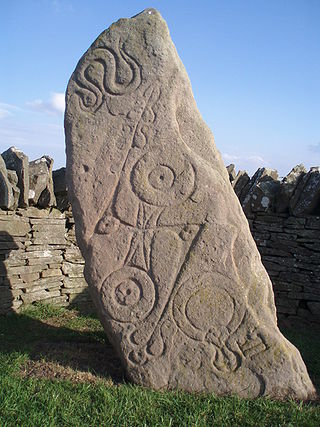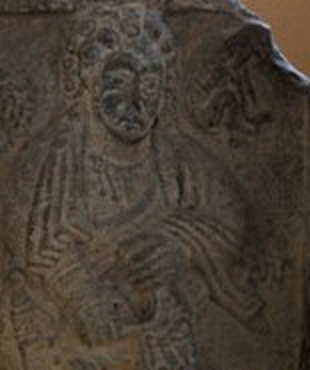Related Research Articles
Áed mac Cináeda was a son of Cináed mac Ailpín. He became king of the Picts in 877, when he succeeded his brother Constantín mac Cináeda. He was nicknamed Áed of the White Flowers, the wing-footed or the white-foot.
Causantín mac Cináeda was a king of the Picts. He is often known as Constantine I in reference to his place in modern lists of Scottish monarchs, but contemporary sources described Causantín only as a Pictish king. A son of Cináed mac Ailpín, he succeeded his uncle Domnall mac Ailpín as Pictish king following the latter's death on 13 April 862. It is likely that Causantín's reign witnessed increased activity by Vikings, based in Ireland, Northumbria and northern Britain. He died fighting one such invasion.
Domnall mac Ailpín, anglicised sometimes as Donald MacAlpin and known in most modern regnal lists as Donald I, was King of the Picts from 858 to 862. He followed his brother Kenneth I to the Pictish throne.

The Picts were a group of peoples who lived in Britain north of the Forth–Clyde isthmus in the Pre-Viking, Early Middle Ages. Where they lived and details of their culture can be inferred from early medieval texts and Pictish stones. The term Picti appears in written records as an exonym from the late third century AD, but was adopted as an endonym in the late seventh century during the Verturian hegemony. This lasted around 160 years until the succession of the Alpínid dynasty, when the Pictish kingdom merged with that of Dál Riata to form the Kingdom of Alba. The concept of "Pictish kingship" continued for a few decades until it was abandoned entirely as a contemporary signifier during the reign of Caustantín mac Áeda.
Óengus mac Fergusa was king of the Picts from 820 until 834. In Scottish historiography, he is associated with the veneration of Saint Andrew, the patron saint of Scotland. Although, this has not been proven.
Giric mac Dúngail, known in English simply as Giric and nicknamed Mac Rath, was a king of the Picts or the king of Alba. The Irish annals record nothing of Giric's reign, nor do Anglo-Saxon writings add anything, and the meagre information which survives is contradictory. Modern historians disagree as to whether Giric was sole king or ruled jointly with Eochaid, on his ancestry, and if he should be considered a Pictish king or the first king of Alba.

Abernethy is a village in Perth and Kinross, Scotland, situated 8 miles (13 km) south-east of Perth.

Óengus son of Fergus, was king of the Picts, of possible Gaelic origin, from 732 until his death in 761. His reign can be reconstructed in some detail from a variety of sources. The unprecedented territorial gains he made from coast to coast, and the legacy he left, mean Óengus can be considered the first king of what would become Scotland.

Bridei son of Maelchon was king of the Picts from 554 to 584. Sources are vague or contradictory regarding him, but it is believed that his court was near Loch Ness and that he may have been a Christian. There were contemporaries claiming the title "king of the Picts". He died in the mid-580s, possibly in battle, and was succeeded by Gartnait son of Domelch.
Naiton son of Der-Ilei, also called Naiton son of Dargart, was king of the Picts between 706–724 and between 728–729. He succeeded his brother Bridei in 706. He is associated with significant religious reforms in Pictland. He abdicated in 724 in favour of his nephew and became a monk. In 728 and 729 he fought in a four-sided war for the Pictish throne.
Uuen son of Onuist, commonly referred to by the hypocoristic Eóganán, was king of the Picts between AD 837–839.
Conall mac Taidg was a king of the Picts from 785 until 789. Very little is recorded of Conall. He is mentioned twice by the Irish annals, the most reliable source for the history of northern Britain in the years around 800. He also appears in later king lists.

Bridei son of Beli was king of Fortriu and of the Picts from 671 until 692. His reign marks the start of the period known to historians as the 'Verturian Hegemony', a turning point in the history of Scotland, when the uniting of Pictish provinces under the over-kingship of the kings of Fortriu saw the development of a strong Pictish state and identity encompassing most of the peoples north of the Forth.
Nechtan grandson of Uerb, was king of the Picts from 595 to around 616, and may be the same person as the Neithon son of Guipno who ruled the kingdom of Alt Clut.
Gartnait, son of Domelch, was a king of the Picts from 584 to 595.
Neithon son of Guipno was a 7th-century ruler of Alt Clut, a Brittonic kingdom based on Dumbarton Rock. According to the Harleian genealogies, he was the son of Guipno map Dumnagual Hen. Alfred Smyth suggests he is the same man as King Nechtan the Great of the Picts, and perhaps the Nechtan son of Canu the Annals of Ulster record as having died in 621. The Senchus fer n-Alban indicate that Gartnait, the son of Áedán mac Gabráin, King of Dál Riata, sired a son named Cano, but unless the Harleian genealogies are to be ignored, this would make Gartnait and Dumnagual Hen the same persons, as the respective fathers of Gartnait and Guipno. However, it is possible that either as an Alt Clut Briton ascending the throne of Pictland, or as a Pict ascending the throne of Alt Clut, his genealogy might have been altered, and it is notable that in the Pictish king-lists he is called "Nechtan, nepos Uerb", suggesting that it was a descent from Uerb that mattered in Pictland, and not his unimportant father Guipno/Canu. Alan Orr Anderson pointed out that Uerb is probably the Pictish form of Ferb, a female name. Alan MacQuarrie suggests that Neithon was indeed the Pictish king Nechtan, but does not take any stance on the Guipno/Canu problem.
Taran son of Ainftech was a King of the Picts from 693 until 697, according to the Pictish king-lists. His name is the same as that of the Gaulish thunder-god, Taranis.
Drest son of Donuel was king of the Picts from c.663 until 672. Like his brother and predecessor Gartnait son of Donuel, and Gartnait's predecessor Talorgan son of Eanfrith, he reigned as a puppet king under the Northumbrian king Oswiu. Gartnait and Drest may have been sons of Domnall Brecc, who was king of Dál Riata from c.629 until he was killed in 642.
Talorg son of Uuid was a king of the Picts from 641 to 653.
References
- Anderson, Alan Orr (1990) [1922], Early Sources of Scottish History A.D 500–1286, vol. 1 (2nd ed.), Stamford, Lincs.: Paul Watkins, ISBN 1-871615-03-8
- Anderson, Marjorie O. (1980), Kings and Kingship in Early Scotland (2nd ed.), Edinburgh: Scottish Academic Press, ISBN 0-7011-1604-8
- Evans, Nicholas (2008), "Royal succession and kingship among the Picts" (PDF), The Innes Review, Edinburgh: Edinburgh University Press, 59 (1): 1–48, doi:10.3366/e0020157x08000140, hdl: 20.500.11820/657d2747-c29d-4254-989d-eb23970a9684 , ISSN 0020-157X
- Fraser, James E. (2009), From Caledonia to Pictland: Scotland to 795, The New Edinburgh History of Scotland, vol. I, Edinburgh: Edinburgh University Press, ISBN 978-0-7486-1232-1
- Smyth, Alfred P. (1998) [1984], Warlords and Holy Men: Scotland AD 80-1000, The New History of Scotland, Edinburgh: Edinburgh University Press, ISBN 0-7486-0100-7